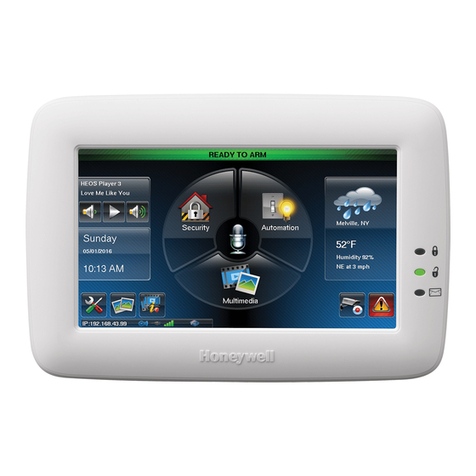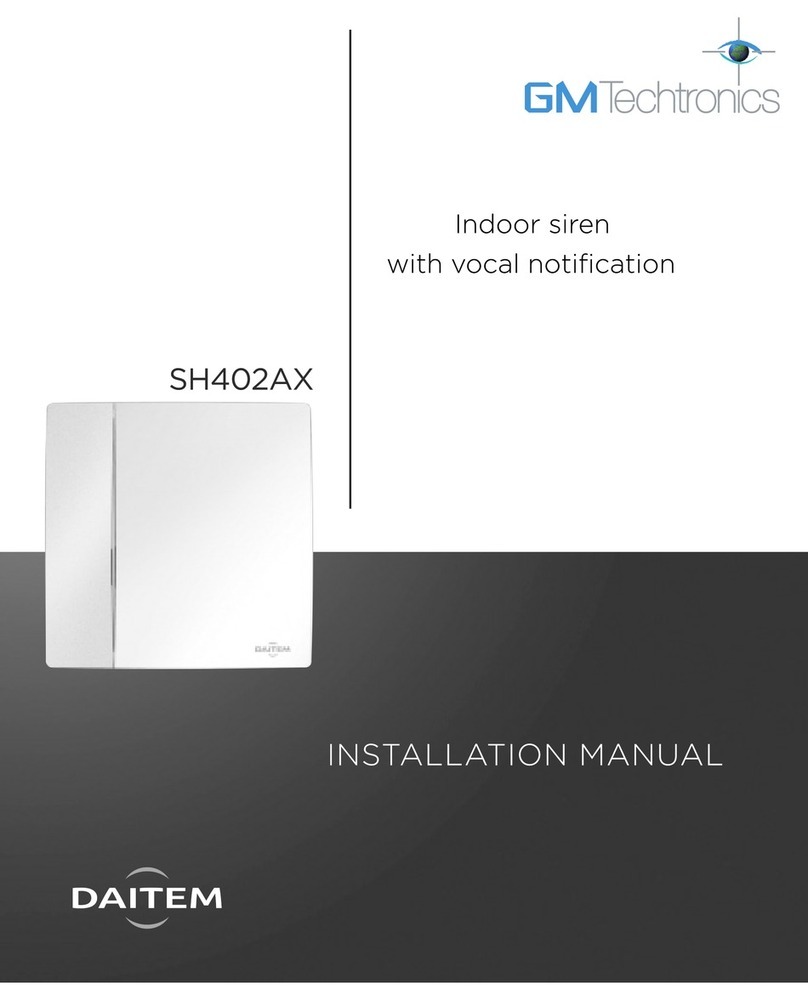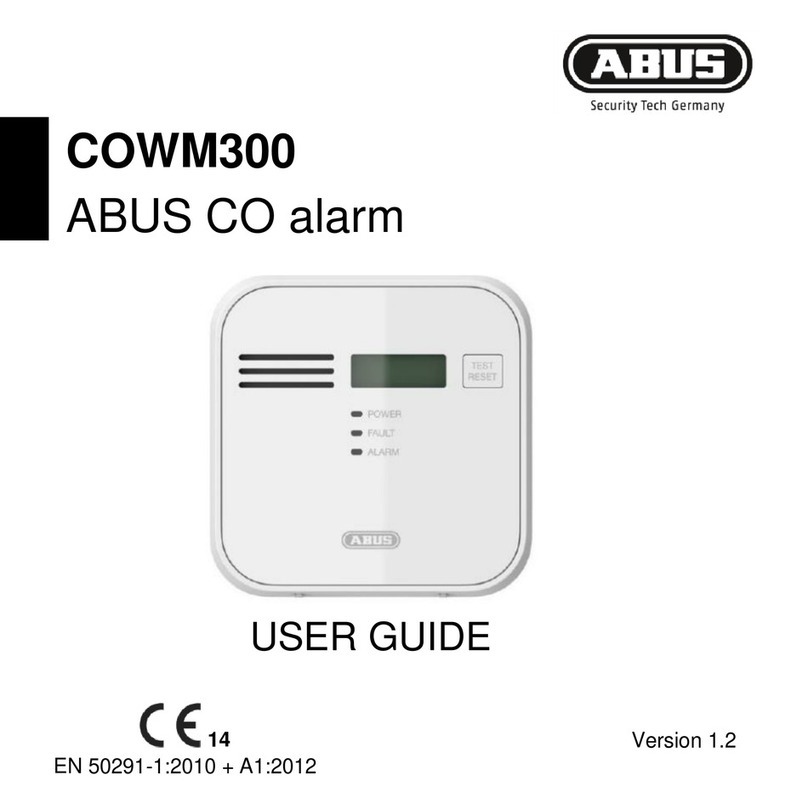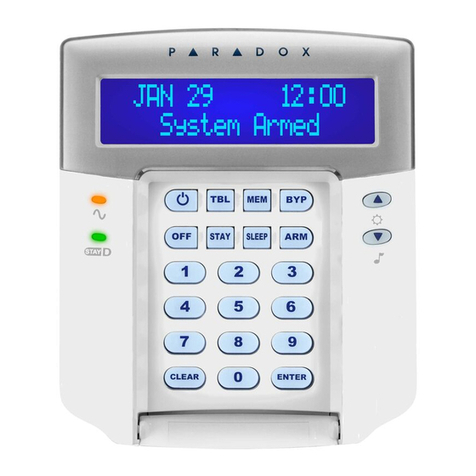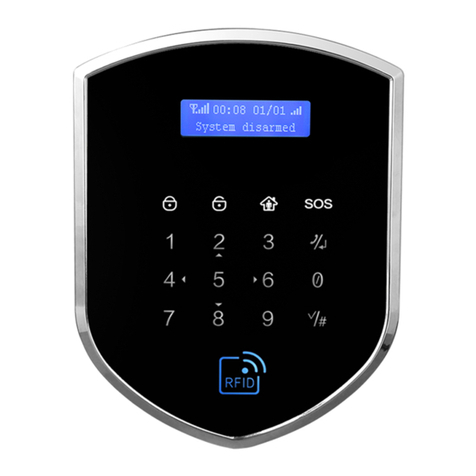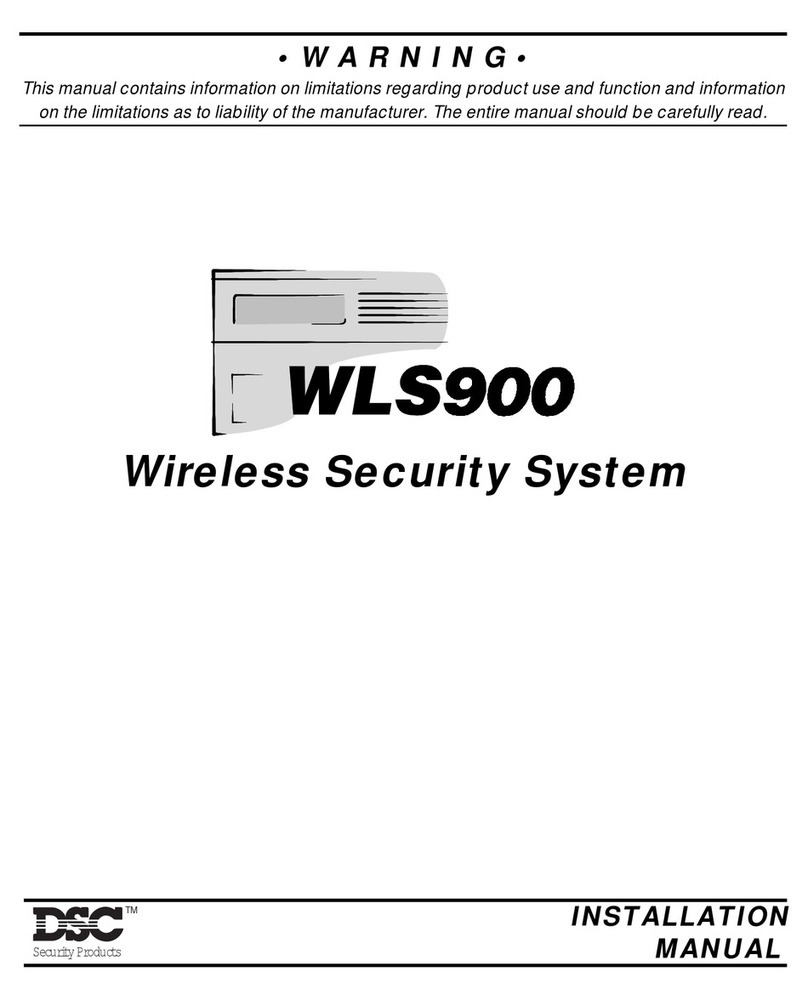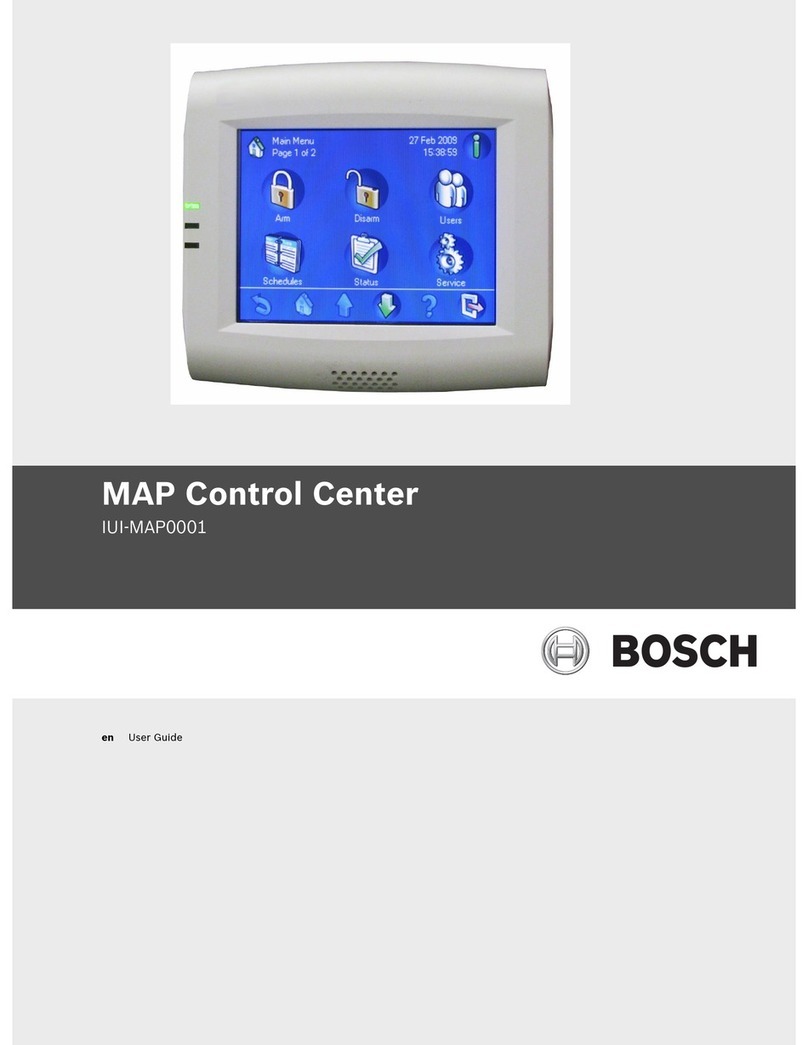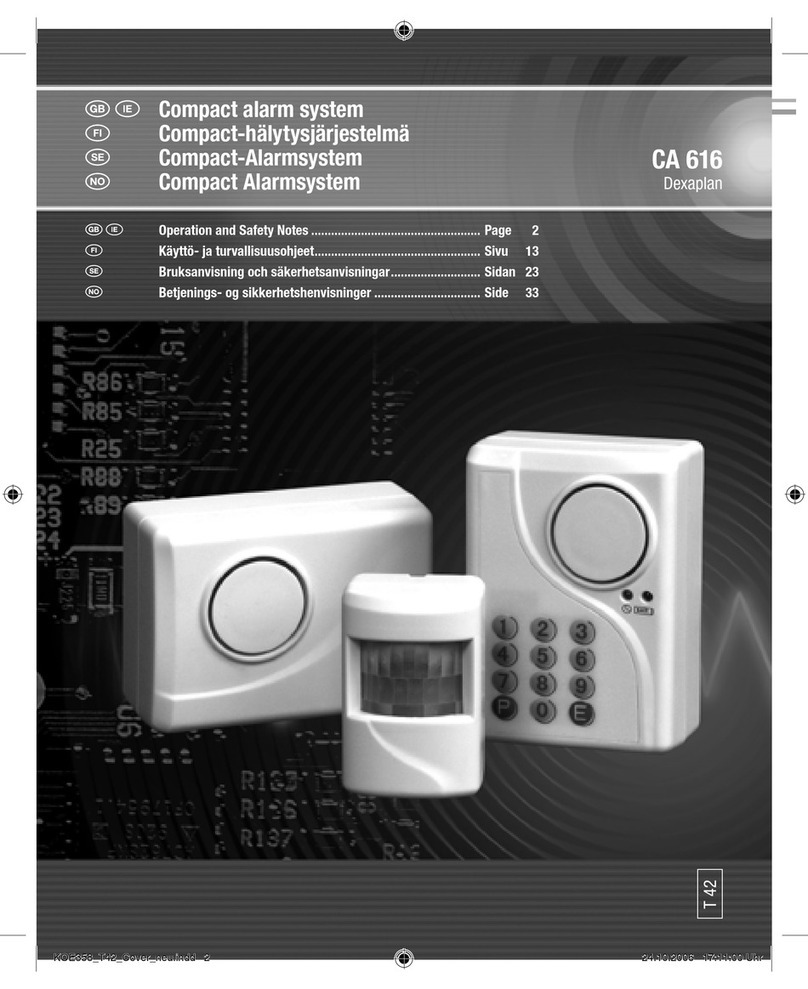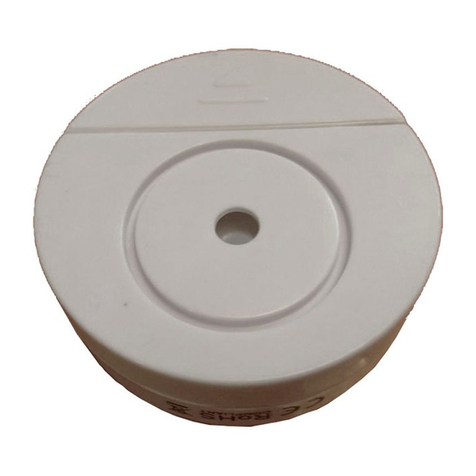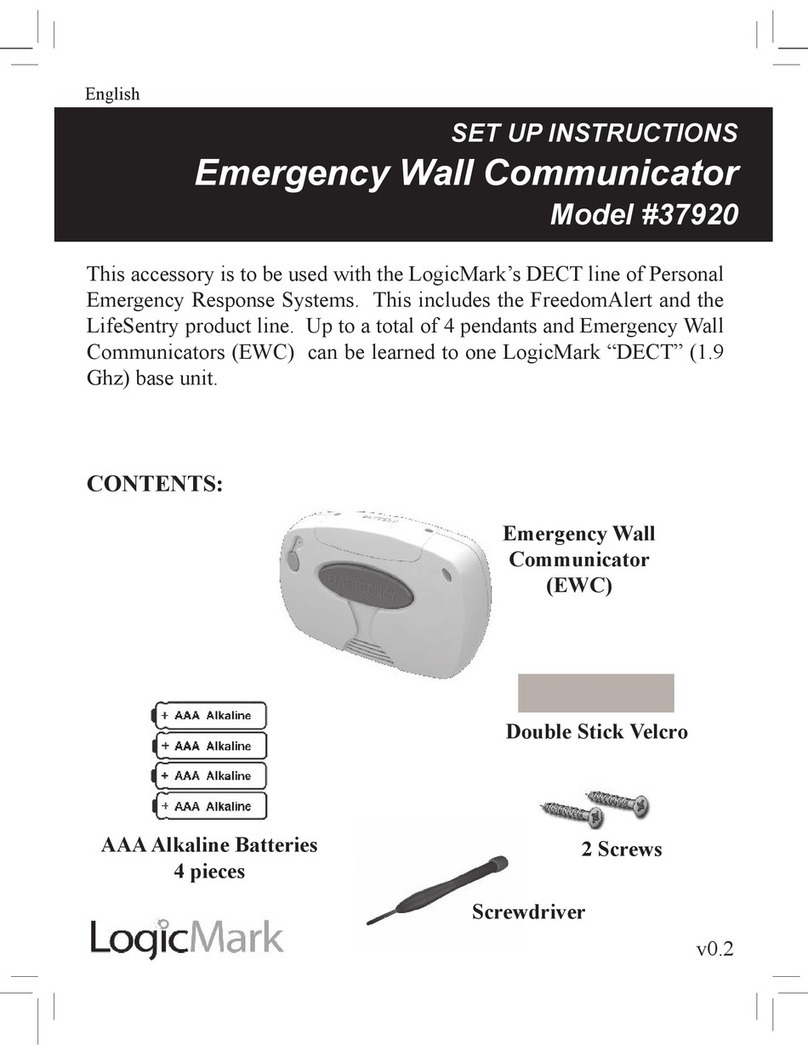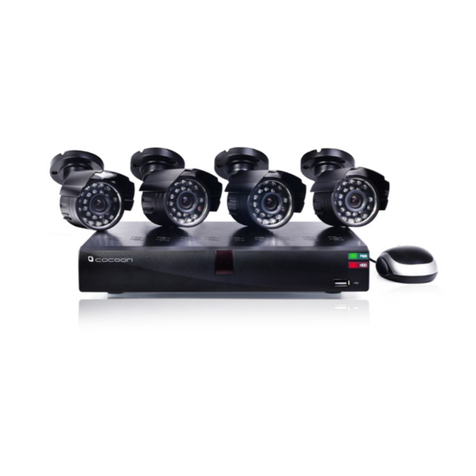CPVan CP3 User manual

USER MANUAL (EN)
BEDIENUNGSANLEITUNG (DE)
MANUALE PER L’UTENTE (IT)
MANUAL DE USUARIO (ES)
MANUEL DE L’UTILISATEUR (FR)
取扱説明書(JP)

USER MANUAL (EN)
Contents
Introduction............................................................................................................2
Important: Extending your CPVan Home Alarm Starter Kit...............................2
Box contents..........................................................................................................2
Product Overview..................................................................................................3
Alarm unit............................................................................................................3
Door sensor.........................................................................................................3
Remote Control...................................................................................................3
First preparation of the Alarm unit.......................................................................4
Pressing the buttons.............................................................................................4
Using the Alarm unit.............................................................................................4
Change the sound.................................................................................................4
Entering the pairing mode....................................................................................4
Using the remote control......................................................................................5
Installation of a door sensor................................................................................5
General guidelines................................................................................................6
Pairing with sensors and remote control...........................................................6
Unpairing remote controls and sensors with the Alarm unit...........................7
Deleting the remote control.................................................................................7
Deleting the sensors for one zone.....................................................................8
Change pincode...................................................................................................8
Adjusting the Volume..........................................................................................8
Changing the batteries........................................................................................8
Remote control.................................................................................................8
Alarm unit..........................................................................................................8
Door sensor.......................................................................................................8
Adding Alarm units, remote controls and sensors..........................................9
Factory reset........................................................................................................9
Frequently asked questions.............................................................................10
CPVan Home Alarm Starter Kit CP3/CP3 Deluxe
For CPVan Home Alarm System
IMPORTANT: Please also refer to www.cpvans.com for further information and
technical assistance. We are improving our site continuously to make sure you have
the best possible experience with our products. We normally respond within 24 hours
to any questions.
Introduction
Congratulations with your new CPVan Home Alarm Starter Kit. The CPVan Home
Alarm Starter Kit is a versatile alarm system that helps you to detect if people or
animals are entering your home or shop. It allows you to use several different
detection units and technologies with one or more Alarm units in up to 4 different
zones. These detection units ( PIR Motion Sensor, Window/Door sensor ) are
wirelessly connected with an Alarm unit. This Alarm unit can be set to either produce
a Chime sound or an alarming and loud Siren. The alarm unit can be placed on a
fixed position or taken with you as you move around the house or if you go to sleep.
A maximum of 10 sensors can be assigned to each of the 4 zones to a maximum of
40 per Alarm unit. Each sensor can be paired with several Alarm units if required.
Also, up to 20 remote controls can be paired with each Alarm unit to enable you to
equip each of your family or team members with a remote control.
Important: Extending your CPVan Home Alarm Starter Kit:
Only select devices from the CPVan Home Alarm System. Other devices will not be
within 24 hours.
Box contents(CP3)
1 x Alarm unit
2 x Door/Window sensor units
2 x Door/Window sensor magnets
2 x AAA LR03 batteries, alkaline
Remote control
Box contents(CP3 Deluxe)
1 x Alarm unit
1 x Door/Window sensor units
1 x Door/Window sensor magnets
1 x Motion detector
1 x AAA LR03 batteries, alkaline
1 x Remote control

Product Overview First preparation of the Alarm unit
Remove the back cover, take out the 2 AAA batteries and the insulating strip in the
Alarm unit and close the lid. You will hear a beep and the indicator light on the
Alarm unit will light. Your Alarm unit is now active.
Take out the insulating strip in each Door sensor (inside Lithium battery).
Please note the correct orientation of the batteries (+ /-).
Pressing the buttons
Alarm unit
A. Siren/Chime Integrated
B. Visual Indicator for 4 different zones
C. 30 seconds Exit delay /
D. Arm Button
E. Switch Voice / Switch from Siren to Chime vice versa
A
E
B
CE
C
D
Door & window sensor
AB
A. Sensor B. Magnet
The sensor contains the electronic detection system for the magnet. If the magnet
is separated from the sensor, a wireless signal is sent to the Alarm unit. The Alarm
unit will then transmit an audible signal (alarm).
Remote Control
A. Bell button:triggers a loud emergency alarm
B. Delay button:30 seconds delay Exit
C. Arm button:activate the Alarm unit
D. Disarm:deactivate the Alarm unit
IMPORTANT: There are 2 ways to press the buttons on your Alarm unit:
. Short press: press the button for 1 second or less.
. Long press: keep the button pressed for 5 seconds.
Usually, the long press of 5 seconds is used to enter a programming or pairing mode.
This procedure prevents that important settings are changed accidentally.
Using the Alarm unit
The alarm unit can be operated both through the remote control as well as by
switching the buttons on the side.
Switch : Home working mode which means when detector is triggered, it will alarm
immediately. when the unit is switched and a beep will be heard.
Switch : 30 seconds delay mode. The alarm unit will be activated after 30 seconds.
when the unit is switched and a beep will be heard.
Arm/Disarm: Make sure the Alarm unit is switched on. Now, short press the Arm
button once. A beep will be heard and the visual indicator will light up once when
the unit is armed, and input the 4 digital correct code (the default code is 1234), 2
beeps will be heard and the visual indicator will light up twice if the unit is disarmed.
IMPORTANT: Your Alarm unit is equipped with a memory function. This means that
the Alarm unit will always come back to its last settings when switched on. If it was
armed when it was switched off, it will be armed when it is switched On again.
However, if it was disarmed when it was switched Off, it will be disarmed when
switched On again. In this case, to arm the Alarm unit just short press the Arm
button [ ] .
Change the sound: Make sure the Alarm unit is switched on. Toggle Change the
between sounds by slide the Button [ / ] . A short confirmation sound will be
heard if the sound is changed.
Entering the Pairing mode: Make sure the Alarm unit is switched On. Long press the
one of four digital button. The opposite light on the front of the Alarm unit are now lit.
See the Chapter “Pairing with sensors and remote controls” for further instructions on
how to pair devices with the Alarm unit.

When a sensor is triggered: 4 digital LED’s which can be used to see which zone is activated in Siren mode (but
not in Chime mode). Please note that one door sensor has been paired with Zone 1
and the other door sensor has been paired to Zone 2 out of the factory as a standard.
This will get you started quickly.
IMPORTANT: In the procedure below you will need to activate sensors to pair them
with the Alarm unit. A door sensor can be activated by keeping the sensor and magnet
against each other and then move them away from each other. A PIR sensor can be
activated by waving your hand in front of it or press the light which showing below
the CPVan.
GENERAL GUIDELINES:
Entering pairing mode
• Long press the one of four digital button on the Alarm unit to enter pairing mode.
The respective light on the front will light up.
The sound will be heard, Chime or Siren.
If the Siren is selected as a notification sound, the LED lights will indicate which
zone triggered the alarm (one of the four LEDs will light up).
If the Chime sound was selected as a notification sound, all 4 LEDs will light to
indicate a sensor was triggered but the zone will not be indicated.
Using the remote control
The supplied remote control will work with multiple Alarm units if required.
There are four buttons on the remote control:
Button Action What happens if pressed
Bell Button Alarm will sound Siren sounds loud. Press Disarm button to stop
Delay button 30 seconds delay Exit Alarm unit is activated after 30 seconds
Arm button Switch On Alarm unit is activated
Disarm button Switch Off Alarm unit is deactivated
Installation of a door sensor
• Do not install the Door/Window sensors on breakable material, but choose instead
the frame of a window to attach your Door/Window sensor.
• Do not install on instable parts.
•
Do not install the sensor near magnetic parts that might trigger the alarm by accident.
• Clean the surface before installation if the tape will be used for attachment.
• It is important that the sensor and the magnet are placed on the door and frame
respectively to allow an alarm to be triggered when sensor and magnet are separated.
Pairing with sensors and remote control
The Alarm unit is already paired with the remote control and the door sensors. Use
this procedure to connect more door & window detectors from the CPVan Home
Alarm System.
IMPORTANT: Factory setup: The visual indicator on the front of the Alarm unit has
Setup Zone 1
• Make sure the Alarm unit is On.
• Long press the digital button [ ] once to select Zone 1. The relevant [ ] light is
now lit.
• Activate the respective unit (door sensor or PIR) which corresponds to Zone 1.
Two beeps will be heard. The sensor for Zone 1 is now properly connected.
Meantime,the light will be off and exit the pairing mode. Other sensors can be
connected for this zone by activating it at last stage.
Setup Zones 2-4
• Long press the digital button [ ] to select the zone 2.The relevant [ ] light is now lit.
• Activate the respective units (door sensor or PIR) which correspond to Zone 2.
Two beeps will be heard. The sensor for Zone 2 is now properly connected.
Meantime,the light will be off and exit the pairing mode. Other sensors can be
connected for this zone by activating it at last stage.
• Long press the one of digital button [ , ] to select Zone 3 or Zone 4 and do as
described to add further sensors, The respective zone is now properly connected, the
light will be off and exit the pairing mode.
Pairing with remote control
Your remote control is ready for use and already paired with your Alarm unit but you
can add more remote controls if desired.
1.
Enter the pairing mode by long pressing the arm button [ ]. All red lights are now lit.
2. Press the arm or disarm button on your remote once. Two beeps will be heard as
a confirmation, all red lights will be off and exit the pairing mode.

Changing the batteries
1. Remote control: The battery can be changed by open the cover on the back of
the remote control. Remove the back panel and replace the battery. The battery type
is CR2032 (3V, Lithium battery).
2. Alarm unit: Slide off the back panel and replace the batteries with 2x AAA size
1.5V Alkaline batteries.
3. Door sensor: Remove the back panel by open the cover and replace the battery
with a new one. The battery type is CR2450 (3V, Lithium battery).
Your remote control is now paired. Multiple remotes can be connected to any Alarm
unit. Also, the remote control can be linked to multiple Alarm units using the method
described.
Adjusting the Volume
1. There are four volume level can be adjustment [Mute, Low, Medium, High]
2. Press the digital button [ ],[ ] simultaneously, 1 Beep will be heard into the
setting mode, again press the digital button [ ] to adjust the volume from [Mute,
Low, Medium, High], press the arm button [ ] to exit the setting mode.
Adding Alarm units, remote controls and sensors
This CPVan alarm system is extremely versatile and flexible. If you have a starter
kit installed, you can add many more CPVan sensors to adapt it to your exact
requirements. You can extend your system with more CPVan Door and Window or
PIR Motion sensors.Up to 10 sensors per zone in total 40 sensors.
Another great feature is that the system can be expanded with more Alarm units
because each sensor can be connected to multiple Alarm units. This allows you to
hear the alarm at multiple places, eg in your living room as well as in your bed room.
Each Alarm unit can be set with different alarm sounds (Siren or Chime) if required.
Adding remote controls is easy. Each alarm unit can be paired with 5 or more
remote controls and each remote control can control multiple Alarm units
simultaneously. This means that each member of your family or team can switch the
system on or off when they require it. Your home will never be unprotected.
IMPORTANT: If you want to add remote controls and sensors, please only select
devices from the CPVan Home Alarm System. Other devices will not be compatible.
respond within 24 hours.
Unpairing remote controls and sensors with the Alarm unit
Zones can be reset individually. Doing so allows you to disconnect the sensors for
just that zone. The Alarm unit also can be disconnected from all remote controls (if
you are using more than one).
IMPORTANT: If more than one remote control is used with the Alarm unit: Please
be aware that there is no option to disconnect just one remote control. With this
procedure, all remote controls are unpaired. Please make sure to again pair the
remote controls you wish to continue to use after you unpaired them.
Deleting the remote control
1. Enter pairing mode by long pressing the arm button [ ] when the Alarm unit is
on. All four lights are now on.
2. Now, again long press the arm button [ ]. 4 Beeps will be heard and the light will
flash and off. All remote controls have now been disconnected from your Alarm unit.
Deleting the sensors for one zone.
1. Enter pairing mode by long pressing the one of four digital button [ , , , ]
when the Alarm unit is on. The respective light is now on.
2. Now, again long press the respective digital button, 4 Beeps will be heard and the
light will flash and off. The settings for this zone have now been cleared.
Change the pincode
1. Remove battery
2. Press and hold any numbered button( 1-4)
3. Insert batteries
4. Release button while 5 Beeps will be heard and the light will flash and off, again
press the new pincode you want to change( try as many times as needed)
5. then press the arm button[ ], all four lights will flash and off. The code reset is
now completed.
CPVan Door/Window Sensor CPVan PIR motion detector
The CPVan Home Alarm System can be extented panded with more Alarm units
because each sensor can be connected to multiple Alarm units. This allows you to
hear the alarm at multiple places, e.g. in your living room as well as in your bed room.
Each Alarm unit can be set with different alarm sounds (Siren or Chime) if required.

Q: Where can I find more information and instructional video’s?
A: Please visit www.cpvans.com for additional information.
Q: I want to add sensors like a window & door sensor or another PIR motion
detector. Where can I find these?
A: All our products are offered on Amazon CPVan Direct Storefront . You can also
visit www.cpvans.com for more information availability.
Q: I have a question and cannot find the answer in this manual
Factory reset
1. Remove battery
2. Press and hold the ARM button
3. Insert batteries
4. Release button after flashes and tones stop
5. All detectors and remote controls have been removed
Frequently asked questions
Q: The Alarm unit does not give an alarm when a detector is activated
A1: Maybe the system is not armed yet. Short press the arm button【 】to switch
the Alarm unit on.Or press the arm button【 】on remote control to arm the device.
A2. Are the sensors active? The red light on the sensor should light up if the sensor
is activated.
A3. Maybe the batteries are running empty. In this case, replace the batteries.
A4. Sometimes the signal cannot penetrate concrete walls or cover large distances
between Alarm unit and the sensor. Take the Alarm unit and hold it close to the
sensor whilst activating it.This will show if the distance between the units is too high.
Q: The Alarm Unit does not enter pairing mode when pressing the digital
button [ , , , ].
A1: The device might be on arm mode. Try short pressing the arm button【】to
switch the unit disarm mode. Now, enter Pairing mode by long pressing the one of
four digital button [ , , , ].
A2: Check the batteries. They might be empty.
Q: The remote-control indicator light is on when I press a button but the Alarm unit
does not react to it.
A1: The signal might not penetrate thick concrete walls or cover large distances.
Try holding the remote control closer to check this.
A2: Try opening the remote control and taking the battery out- and back in again.
A3: The battery is running out of power. Insert a new battery.
BEDIENUNGSANLEITUNG (DE)
Contents
Einleitung.............................................................................................................2
Was ist im Hausalarm Starter Set enthalten? ..................................................3
Übersicht über das Hausalarm Starter Set.......................................................3
Alarmeinheit........................................................................................................3
Tür & Fenster Sensor.........................................................................................4
Fernbedienung................................................................................................... 4
Vorbereitung der Alarmeinheit..........................................................................5
Wie Sie die Einstellknöpfe richtig nutzen........................................................5
Wie Sie die Alarmeinheit nutzen.......................................................................5
Wie Sie die Fernbedienung nutzen...................................................................6
Installation des Tür & Fenster Sensors...........................................................6
Verbinden mit Sensoren und der Fernbedienung...........................................7
Verbinden einer Fernbedienung mit der Alarmeinheit....................................8
Entfernen von Fernbedienungen und Sensoren.............................................8
Entfernen einer Fernbedienung........................................................................8
Entfernen der Sensoren aus einer Zone..........................................................9
Den Code zurücksetzen.....................................................................................9
Umstellung der Lautstärke................................................................................9
Austauschen der Batterien................................................................................9
Fernbedienung: Entfernen Sie die Schraube auf der Rückseite der
Fernbedienung. Entfernen Sie nun die Abdeckung. Die Batterie ist nun
zugänglich and kann ausgetauscht werden. Der korrekte Batterie-Typ ist
CR2032 (3V, Lithium-Batterie)...........................................................................9
Alarmeinheit: Entfernen Sie die Batteriefach-Abdeckung durch Verschieben
und ersetzen Sie die 2 x AAA (1,5V) Alkaline-Batterien.................................9
Tür & Fenster Sensor: Entfernen Sie die rückseitige Abdeckung des Sensors
und ersetzen Sie die Lithium-Batterie Typ CR2450 (3V)................................9
Erweitern des Systems mit weiteren Alarmeinheiten, Sensoren und
Fernbedienungen..............................................................................................9
Häufig gestellte Fragen und Antworten..........................................................10

CPVan Hausalarm Starter Set
WICHTIG: Bitte besuchen Sie auch unsere Webseite www.cpvans.com für weitere
Informationen und technische Unterstützung bei der Installation. Wir verbessern
und erweitern unsere Webseite ständig. Sie finden dort die aktuellsten
Informationen über unsere Produkte. Gern können Sie sich auch an uns wenden.
Üblicherweise reagieren wir auf Ihre Fragen innerhalb von 24 Stunden.
Was ist im Hausalarm Starter Set enthalten? (CP3 Deluxe)
Für CPVan Home Alarm System
Einleitung
Wir beglückwünschen Sie zum Kauf des CPVan Hausalarm Starter Sets. Dieses
Alarmsystem ist vielseitig einsetzbar und hilft Ihnen, unerwünschten Zutritt zu
Ihrem Haus oder Geschäft zu vermeiden. Das System ermöglicht es, verschiedene
Sensoren mit einer oder mehreren Alarmeinheiten intelligent miteinander zu
verbinden in am meisten 4 Zonen. Als Sensoren stehen Fenster & Tür Sensoren
sowie PIR Bewegungsmelder zur Verfügung und können drahtlos mit einer oder
mehreren Alarmeinheiten verbunden werden.
Je nach Nutzung bietet die Alarmeinheit die Möglichkeit, entweder einen Alarmton
oder einen Benachrichtigungston abzugeben. Die Alarmeinheit kann entweder an
einer entsprechenden Position fixiert, aber auch mobil bleiben. Dies ermöglicht es
Ihnen, die Alarmeinheit innerhalb oder in der Umgebung des Hauses mit sich zu
nehmen.
Die Alarmeinheit unterstützt 4 verschiedene Alarmzonen. Jede Zone kann mit 10
verschiedenen Sensoren verbunden werden. Dies erlaubt ein Maximum von
insgesamt 40 verschiedenen Sensoren für jede Alarmeinheit. Auch das Hinzufügen
von bis zu 20 Fernbedienungen ist möglich, sodass jedes Familien- oder
Teammitglied mit einer Fernbedienung ausgerüstet werden kann.
Wichtig: Wie Sie Ihr CPVan Hausalarm Starter Set erweitern?
Es können nur Sensoren und Fernbedienungen für das CPVan Home Alarm
System hinzugefügt werden. Andere Produkte sind nicht kompatibel. Kontaktieren
üblicherweise innerhalb von 24 Stunden.
Was ist im Hausalarm Starter Set enthalten? (CP3)
1 x Alarmeinheit
2 x Tür & Fenster Sensoren
2 x Tür & Fenster Magnete für Sensoren
2 x AAA LR03 Batterien, Alkaline
Fernbedienung
1 x Alarmeinheit
1 x Tür & Fenster Sensoren
1 x Tür & Fenster Magnete für Sensoren
1 x PIR Bewegungsmelder
1 x AAA LR03 Batterien, Alkaline
Fernbedienung
Übersicht über das Hausalarm Starter Set
Alarmeinheit
A
E
B
CE
C
D
A. Sirene/Chime integriert
B. Visueller Anzeiger für 4 verschiedene Zonen
C. 30 Sekunden Ausgangsverzögerung /
D. Scharfschalten-Knopf [ ]
E. Stimme umschalten / Umschalten zwischen Alarmton & Ankündigungston
Tür & Fenster Sensor
AB
A. Sensor B. Magnet
Der Sensor enthält das elektronische Detektionssystem für den Magneten. Ein
drahtloses Signal wird an die Alarmeinheit gesandt, wenn der Magnet vom Sensor
entfernt wird. Dies führt zum Auslösen des Alarms.

Fernbedienung und der visuelle Anzeiger leuchtet einmal auf, wenn das Gerät scharfgeschaltet ist.
Wenn Sie dann den 4-stelligen korrekten digitalen Code eingeben (der Standardcode
ist 1234) und das Gerät damit entwaffnen, werden 2 Pieptöne zu hören sein. Der
visuelle Anzeiger wird auch zweimal aufleuchten.
WICHTIG: Die Alarmeinheit hat eine eingebaute Erinnerungsfunktion. Das heißt,
nach erneuter Einschaltung wird die Alarmeinheit in dem zuletzt genutzten Modus
vor der Ausschaltung fortfahren. Wenn die Alarmeinheit im geschärften Zustand
ausgeschaltet wurde, wird sie nach erneuter Einschaltung in den geschärften Modus
zurückkehren. Falls die Alarmeinheit im ungeschärften Modus ausgeschaltet wurde,
wir sie auch in den ungeschärften Modus nach erneuter Einschaltung zurückkehren.
In diesem Fall brauchen Sie nur den Arm-Knopf [ ] kurz zu drücken, um die
Alarmeinheit in den geschärften Modus zu bringen.
Wechsel zwischen Alarmton und Ankündigungston: Stellen Sie sicher, dass die
Alarmeinheit eingeschaltet ist. Wechseln Sie zwischen den beiden Tönen, indem Sie
die Taste ( / ) kurz verschieben. Ein kurzer Bestätigungston wird gehört, wenn
der Ton erfolgreich geändert wird.
Starten des Verbindungsmodus: Stellen Sie sicher, dass das Alarmgerät
eingeschaltet ist. Drücken Sie lange eine der vier digitalen Knöpfe. Das
entsprechende Licht an der Vorderseite der Alarmeinheit wird dann leuchten.
Für weitere Informationen darüber, wie man die Geräte miteinander verbinden kann,
lesen Sie bitte das Kapitel "Verbinden mit Sensoren und der Fernbedienung".
A. Notfallknopf: ein lauter Alarm wird sofort ausgelöst
B. Verzögerungsknopf: die Alarmsystemsaktivierung des
Hausausgangs wird um 30 Sekunden verzögert
C. Scharfschalten-Knopf: Aktivieren/Schärfen der Alarmeinheit
D. Unscharfschalten-Knopf: Unscharfschalten der Alarmeinheit
Vorbereitung der Alarmeinheit
Öffnen Sie den Deckel, nehmen Sie die beiden mitglieferten AAA-Batterien heraus
und entfernen Sie den Isolierstreifen in der Alarmeinheit. Dann schließen Sie sie bitte
wieder. Sie hören einen Signalton und die Anzeigeleuchte an der Alarmeinheit
leuchtet auf. Ihre Alarmeinheit ist jetzt aktiv. Entfernen Sie den Isolierstreifen in
jedem Sensoren. (Zwischen den Lithium-Batterien) Bitte beachten Sie die korrekte
Orientierung beim Einsetzen der Batterien (+/-).
Wie Sie die Einstellknöpfe richtig nutzen
WICHTIG: Es gibt zwei Möglichkeiten, die Knöpfe der Alarmeinheit zu drücken:
Kurzes Drücken: drücken Sie den Knopf für eine Sekunde oder weniger.
Langes Drücken: drücken und halten Sie den Knopf für 5 Sekunden.
Üblicherweise wird das lange Drücken (5 Sekunden) zum Starten der
Programmierung oder des Verbindungsmodus für Sensoren genutzt. Dadurch
verhindert es auch, dass versehentlicherweise wichtige Einstellungen ungewollt
geändert werden.
Wie Sie die Alarmeinheit nutzen
Die Alarmeinheit kann entweder durch die Fernbedienung oder durch die Knöpfe an
der Seite der Alarmeinheit genutzt werden.
Umschalten : Home-Arbeitsmodus. Das heißt, wenn der Detektor ausgelöst wird,
wird sofort Alarm gegeben. (Wenn die Alarmeinheit auf ( ) umgeschaltet und ein
Piepton danach gehört wird).
Umschalten : 30-Sekundiger Verzögerungsmodus. Nach dem Umschalten wird die
Alarmeinheit in 30 Sekunden aktiviert. (Wenn die Alarmeinheit auf umgeschaltet
und ein Piepton danach gehört wird).
Scharfschalten / Unscharfschalten: Stellen Sie sicher, dass die Alarmeinheit
eingeschaltet ist. Drücken Sie nun einmal kurz den Arm-Knopf . Ein Piepton ertönt
Wenn ein Sensor ein Signal sendet:
- Die Alarmeinheit wird, je nach Einstellung, einen Alarmton order einen
Benachrichtigungston wiedergeben.
- Wenn der Alarmton gewählt ist, kann zusätzlich gesehen werden, in welcher Zone
der Alarm ausgelöst wurde - die entsprechende LED auf der Vorderseite der
Alarmeinheit leuchtet auf.
- Wenn der Benachrichtigungston gewählt ist, werden zusätzlich alle 4 LEDs auf der
Vorderseite aufleuchten - hier wird nicht die entsprechende Zone angezeigt.
Wie Sie die Fernbedienung nutzen
Die mitgelieferte Fernbedienung kann mit verschiedenen Alarmeinheiten verbunden
werden, wenn gewünscht.
Auf der Fernbedienung befinden sich 4 Knöpfe:

Dies soll Ihnen helfen, die Anlage möglichst schnell nutzen zu können.
WICHTIG: In der unten beschriebenen Anweisung müssen Sensoren aktiviert
werden, um sie mit der Alarmeinheit zu verbinden. Ein Tür & Fenster Sensor wird
aktiviert, indem Sie Sensor und Magnet zusammenhalten und dann voneinander
trennen. Ein PIR Bewegungsmelder wird aktiviert, indem Sie Ihre Hand vor dem
Sensor bewegen oder das Licht unter dem CPVan drücken.
Installation des Tür & Fenster Sensors
Starten des Verbindungsmodus
Drücken Sie lange eine der vier digitalen Knöpfe Alarmgerät, um in den
Verbindungsmodus zu wechseln. Das entsprechende Licht an der Vorderseite
wird aufleuchten.
Verbinden von Sensoren in Zonen 2-4
• Drücken Sie lange den digitalen Knopf [ ], um die Zone 2 auszuwählen. Das
entsprechende [ ] -Licht leuchtet nun.
• Aktivieren Sie die entsprechenden Einheiten (Türsensor oder PIR), die der Zone 2
entsprechen. Es ertönen zwei Pieptöne. Der Sensor für Zone 2 ist jetzt richtig
verbunden. In der Zwischenzeit wird das Licht ausgeschaltet und der
Verbindungsmodus endet dann auch. Andere Sensoren können mit dieser Zone
verbunden werden, indem sie in der letzten Stufe aktiviert werden.
• Drücken Sie lange einen der Knöpfe [ , ], um Zone 3 oder Zone 4 auszuwählen.
Die Arbeitsweise ist gleich, um weitere Sensoren hinzuzufügen. Die entsprechende
Zone ist nun ordnungsgemäß verbunden. Das Licht ist dann aus und der
Verbindungsmodus endet auch.
Knopf
Notfallknopf
VerzögerungssKnopf
Scharfschalten
Unscharfschalten
Aktion
Alarm wird ausgelöst
30-Sekundige
Aktivierungsverzögerung
Einschalten
Ausschalten
Was passiert?
Alarmton ist zu hören. Kann
mit Unscharfschalten-Knopf
gestoppt werden.
Nach dem Drücken wird die
Alarmeinheit in 30 Sekunden
aktiviert
Alarmeinheit ist aktiviert
Alarmeinheit ist deaktiviert
ALLGEMEINE RICHTLINIEN:
• Installieren Sie den Tür & Fenster Sensor nicht auf leicht brechbarem
Untergrund-ein solider Untergrund wie beispielsweise ein Fenster- oder Türrahmen
ist empfohlen.
• Installieren Sie den Tür & Fenster Sensor nicht auf instabilen Untergründen.
• Installieren Sie den Tür & Fenster Sensor nicht in der Nähe von magnetischen
Teilen, da dies zu einer Fehlauslösung führen könnte.
• Reinigen Sie die Installationsfläche bitte gründlich, wenn Sie das mitgelieferte
Klebeband verwenden möchten.
• Eine korrekte Installation des Sensors und des Magneten an der Tür und dem
Türrahmen sind von entscheidender Bedeutung für eine korrekte Funktion.
Verbinden mit Sensoren und der Fernbedienung
Die gelieferte Alarmeinheit ist bereits mit den Tür & Fenster Sensoren sowie
mit der Fernbedienung verbunden.
Folgen Sie der unten beschriebenen Anweisung, wenn Sie weitere Sensoren des
CPVan Home Alarm Systems hinzufügen wollen.
WICHTIG: Werkseinstellungen: Das Kontrolllicht auf der Vorderseite besteht aus
4 LEDs. Diese zeigen im Alarmmodus (Scharfschaltensmodus) an, in welcher
Zone der Alarm ausgelöst wurde (nicht im Benachrichtigungsmodus). Werksseitig
ist ein Tür & Fenster Sensor mit Zone 1 und der andere mit Zone 2 verbunden.
Verbinden von Sensoren in Zone 1
• Stellen Sie sicher, dass die Alarmeinheit eingeschaltet ist
• Drücken Sie lange den digitalen Knopf [ ], um Zone 1 auszuwählen. Das
entsprechende [ ] -Licht leuchtet jetzt.
• Aktivieren Sie die entsprechende Einheit (Türsensor oder PIR), die der Zone 1
entspricht. Es ertönen zwei Pieptöne. Der Sensor für Zone 1 ist jetzt richtig
verbunden. In der Zwischenzeit wird das Licht ausgeschaltet und der
Verbindungsmodus endet dann auch. Andere Sensoren können mit dieser Zone
verbunden werden, indem sie in der letzten Stufe aktiviert werden.
Verbinden einer Fernbedienung mit der Alarmeinheit
Die gelieferte Fernbedienung ist bereits mit der Alarmeinheit verbunden. Sie können
aber weitere Fernbedienungen hinzufügen.
1. Der Verbindungsmodus wird gestartet, indem Sie lange den Arm-Knopf [ ]
drücken. Alle roten Lichter leuchten jetzt auf.

Umstellung der Lautstärke
1.Vier Lautstärken sind zur Verfügung k [Stumm, Niedrig, Mittel, Hoch]
2.Drücken Sie die digitalen Knöüfe [ ], [ ] gleichzeitig. 1 Piepton wird ertönen
wenn der Einstellungsmodus gestartet wird. Drücken Sie erneut den digitalen Knopf
[ ], um die Lautstärke von [Stumm, Niedrig, Mittel, Hoch] einzustellen. Um den
Einstellungsmodus zu verlassen, drücken Sie bitte den Scharfschalten-Knopf [ ].
2. Drücken Sie einmal den Scharfschalten- oder Unscharfschalten-Knopf auf Ihrer
Fernbedienung. Zwei Pieptöne werden als Bestätigung gehört. Alle roten Lichter
sind dann aus und der Verbindungsmodus endet auch.
Die Fernbedienung ist jetzt mit der Alarmeinheit verbunden. Weitere
Fernbedienungen können so mit der Alarmeinheit verbunden werden.
Fernbedienungen können auch mit mehreren Alarmeinheiten verbunden werden,
indem Sie der oben gegebenen Anweisung folgen.
Entfernen von Fernbedienungen und Sensoren
Sie können Sensoren selektiv von entsprechenden Zonen entfernen. Sie können
auch die Alarmeinheit von allen Fernbedienungen entfernen, falls dass mehrere
Fernbedienungen genutzt werden.
WICHTIG: Falls mehrere Fernbedienungen mit einer Alarmeinheit verbunden
sind - es werden immer alle verbundenen Fernbedienungen gelöscht. Stellen Sie
also nach dem Entfernen aller Fernbedienungen wieder eine Verbindung mit der
Fernbedienung her, mit der Sie weiterarbeiten möchten.
Austauschen der Batterien
WICHTIG: Es können nur Sensoren und Fernbedienungen für das CPVan Home
Alarm System hinzugefügt werden. Andere Produkte sind nicht kompatibel.
reagieren üblicherweise innerhalb von 24 Stunden.
Entfernen einer Fernbedienung
1. Starten Sie den Pairing-Modus, indem Sie den Scharfschalten-Knopf [ ] lange
drücken, wenn die Alarmeinheit eingeschaltet ist. Alle vier Lichter sind jetzt an.
2. Drücken Sie nun erneut lange den Scharfschalten-Knopf [ ]. 4 Pieptöne sind
zu hören und das Licht blinkt und erlischt. Alle Fernbedienungen wurden jetzt von
Ihrem Alarmgerät getrennt.
Entfernen der Sensoren aus einer Zone
1. Starten Sie den Pairing-Modus, indem Sie lange einen der vier digitalen Knöpfe
[ , , , ] drücken, wenn die Alarmeinheit eingeschaltet ist. Das entsprechende
Licht ist jetzt an.
2. Drücken Sie nun erneut den entsprechenden digitalen Knopf. Es ertönen dann 4
Pieptöne und das Licht blinkt und erlischt. Die Einstellungen für diese Zone wurden
jetzt gelöscht.
Den Code zurücksetzen
1. Entfernen Sie eine oder alle Batterien.
2. Drücken Sie lange einen der vier digitalen Knöpfe.
3. Setzen Sie die Batterien wieder ein. Es ertönen 5 Pieptöne und das Licht blinkt
und erlischt. Drücken Sie erneut die vier Codes, die Sie ändern möchten, und
drücken Sie dann den Scharfschalten-Knopf [ ]. Alle vier Lichter blinken und
erlöschen. Die Code-Rücksetzung ist nun abgeschlossen.
Fernbedienung: Entfernen Sie die Schraube auf der Rückseite der Fernbedienung.
Entfernen Sie nun die Abdeckung. Die Batterie ist nun zugänglich and kann
ausgetauscht werden. Der korrekte Batterie-Typ ist CR2032 (3V, Lithium-Batterie).
Alarmeinheit: Entfernen Sie die Batteriefach-Abdeckung durch Verschieben und
ersetzen Sie die 2 x AAA (1,5V) Alkaline-Batterien.
Tür & Fenster Sensor: Entfernen Sie die rückseitige Abdeckung des Sensors und
ersetzen Sie die Lithium-Batterie Typ CR2450 (3V).
Erweitern des Systems mit weiteren Alarmeinheiten, Sensoren und
Fernbedienungen
Das CPVan Home Alarm System ist sehr vielseitig und flexibel. Sie können das
Hausalarm Starter Set mit weiteren CPVan Sensoren (Tür & Fenster Sensor oder
PIR Bewegungsmelder) erweitern und es Ihren Bedürfnissen anpassen. Bis zu 10
Sensoren pro Zone sind möglich - also bis zu 40 Sensoren insgesamt.
Eine weitere Besonderheit ist, dass neben dem Hinzufügen von Sensoren auch
weitere Alarmeinheiten hinzugefügt werden können. Dies erlaubt Ihnen, den Alarm
an verschiedenen Orten im Haus zu hören (Wohnzimmer im EG, Schlafzimmer im
OG, etc).Jede Alarmeinheit kann unterschiedlich entweder mit dem Alarmton (Sirene)
oder dem Benachrichtigungston (Chime) arbeiten.
Das Hinzufügen von weiteren Fernbedienungen ist einfach. Jede Alarmeinheit kann
mit 5 und mehr Fernbedienungen verbunden werden. Jede Fernbedienung kann
ebenfalls mehrere Alarmeinheiten gleichzeitig steuern. Das heißt, dass jedes
Familienmitglied bzw. jedes Teammitglied die Anlage ein- und auch wieder
ausschalten kann. Ihr Zuhause bleibt nicht ungeschützt.

korrekt den Empfänger. Nehmen Sie die Fernbedienung dichter an die Alarmeinheit
und versuchen Sie es erneut. Dies wird zeigen, ob die Entfernung zwischen
Alarmeinheit und Fernbedienung zu groß ist oder etwas zwischen Alarmeinheit und
Fernbedienung das Signal stört.
A2: Öffnen Sie die Fernbedienung. Entnehmen Sie kurz die Batterie und legen Sie
sie wieder ein. Versuchen Sie es erneut.
A3: Überprüfen Sie die Batterie und ersetzen Sie sie gegebenenfalls.
A: All unsere Produkte werden auf Amazon.de verkauft. Besuchen Sie auch
www.cpvans.com für weitere Verfügbarkeiten außerhalb von Amazon.
Das CPVan Home Alarm System kann sehr einfach erweitert werden.
1. Durch das Hinzufügen weiterer Sensoren zu einem CPVan Hausalarm Starter Set
2. Durch das kombinieren mit einem zweiten CPVan Hausalarm Starter Set.
3. Durch das Hinzufügen einer oder mehrerer Alarmeinheiten.
Häufig gestellte Fragen und Antworten
Frage: Die Alarmeinheit gibt aber kein Signal, wenn ein Sensor aktiviert wird?
A1: Vielleicht ist das System noch nicht scharfgeschaltet. Drücken Sie kurz den
Scharfschalten-Knopf【 】, um die Alarmeinheit einzuschalten. Oder drücken Sie
den Scharfschalten-Knopf【 】auf der Fernbedienung, um das Gerät
scharfzuschalten.
A2. Sind die Sensoren aktiv? Ein rotes Kontrolllicht an den Sensoren erscheint,
wenn ein Sensor aktiviert wird.
A3. Ist die Batterie-Stromversorgung ausreichend? Falls nicht, ersetzen Sie die
Batterien.
A4. Häuser sind sehr verschieden gebaut und manchmal erreicht das Signal nicht
korrekt den Empfänger. Nehmen Sie die Alarmeinheit mit zum Sensor und aktivieren
Sie den Sensor erneut. Dies wird zeigen, ob die Entfernung zwischen Alarmeinheit
und Sensor zu groß ist oder etwas zwischen Alarmeinheit und Sensor das Signal stört.
Frage: Die Alarmeinheit wechselt nicht in den Verbindungsmodus, wenn die
digitalen Knöpfe [ , , , ] gedrückt wird.
A1: Das Gerät befindet sich möglicherweise im Scharfschalten-Modus. Versuchen
Sie kurz, indem Sie den Scharfschalten-Knopf【】kurz drücken, um den
Unscharfschalten-Modus der Einheit zu aktivieren.
A2: Überprüfen die Batterien, die möglicherweise leer sind.
Frage: Wo kann ich weitere Informationen und Hilfe-Videos zum Hausalarm
System finden?
A: Bitte besuchen Sie unsere Website www.cpvans.com für zusätzliche Informationen.
CPVan Tür & Fenster-Sensor CPVan PIR Bewegungsmelder
Frage: Die Fernbedienungs-Kontrolllampe leuchtet, wenn ich eine Taste drücke,
aber die Alarmeinheit reagiert nicht.
A1: Häuser sind sehr verschieden gebaut und manchmal erreicht das Signal nicht
Frage: Ich möchte meine Anlage erweitern. Wo kann ich zusätzliche Tür &
Fenster Sensoren oder PIR Bewegungsmelder kaufen?
Frage: Ich habe eine Frage, kann aber die Antwort nicht in der
Gebrauchsanweisung finden.
üblicherweise innerhalb von 24 Stunden.

MANUALE PER L’UTENTE (IT)
Contents
Introduzione............................................................................................................2
Importante: estendere il proprio Starter Kit di allarme domestico CPVan........2
contenuto confezione.............................................................................................2
Presentazione prodotto..........................................................................................3
unità di allarme......................................................................................................3
Sensore porta........................................................................................................3
Telecomando...........................................................................................................3
Preparazione iniziale unità d’allarme....................................................................4
Premere pulsante....................................................................................................4
Utilizzo unità d’allarme...........................................................................................4
Utilizzo telecomando..............................................................................................4
Installazione sensore di porta...............................................................................5
Collegare sensori al telecomando........................................................................5
Collegare al telecomando....................................................................................5
Scollegare telecomado dall’unità centrale...........................................................6
Rimuovere telecomando......................................................................................6
Rimuovere sensori per unz zone........................................................................6
Rimuovere telecomando........................................................................................7
Rimuovere sensori per una zona..........................................................................7
Rimuovere le batteries...........................................................................................7
Telecomando........................................................................................................8
Unità d’allarme.....................................................................................................8
Sensore di porta..................................................................................................8
Aggiungere unità di allarme, telecomandi e sensori.........................................9
Domande frequenti..............................................................................................10
CPVan Home Alarm Starter Kit CP3/CP3 Deluxe
For CPVan Home Alarm System
IMPORTANTE: per ulteriori informazioni o per ricevere assistenza tecnica, si prega
di far riferimento al sito www.cpvans.com. Il sito è in continuo aggiornamento al fine di
garantire la miglior esperienza con il nostro prodotto. Vi risponderemo entro le 24 ore.
Introduzione
grazie per aver scelto il nostro innovativo CPVan Home Alarm Starter Kit. Il CPVan
Home Alarm Starter Kit è un sistema di allarme multifunzione che permette di
rilevare l'entrata in casa vostra o nel vostro negozio di persone o animali. Il sistema
usa diverse unità di rilevamento e tecnologie all'avanguardia. Sarà inoltre, possibile
aggiungere una o più unità d'allarme con una copertura fina a 4 zone diverse.
Queste unità di rilevamento (Sensore di Movimento PIR, sensore Finestra/Porta)
sono connesse in modalità wireless all'unità centrale di allarme. L'unità centrale di
allarme può essere impostata per emettere un segnale acustico continuo o per
riprodurre il suono di una sirena di allarme. Potrete inoltre, decidere se sistemarla in
un posto fisso o portarla con voi quando vi spostate all'interno della casa o andate
a dormire.
Un massimo di 10 sensori puo' essere assegnato per ognuna delle quattro zone da
voi eventualmente scelte,per un totale di 40 unità d'allarme.Ogni sensore puo' essere
collegato a più unità d'allarme, su richiesta. Sarà possibile inoltre, collegare ad ogni
unità di allarme fino a 20 telecomandi separati. In questo modo, ciascun membro
della vostra famiglia potrà possederne uno.
Importante: Per quanto riguarda gli aggiornamenti del nostro CPVan Home Alarm
Starter Kit: usate solo dispositivi che appartengono al CPVan Home Alarm System.
Tutti gli altri dispositivi non saranno compatibili.
Vi risponderemo entro 24 ore.
Contenuto della confezione(CP3)
1 x Unità di Allarme
2 x sensori per porta/finestra
2 x sensori magnetici Porta/Finestra
2 x AAA LR03 batterie alcaline
Telecomando
Contenuto della confezione (CP3 Deluxe)
1 x Unità di Allarme
1 x sensori per porta/finestra

1 x sensori magnetici Porta/Finestra
1 x PIR rilevatore di spostamenti
1 x AAA LR03 batterie alcaline
Telecomando
Presentazione prodotto
A
E
B
CE
C
D
Unità di allarme
A. Sirena/Segnale acustico integrati
B. Indicatore visivo delle 4 diverse zone
C. 30 secondi Uscita/Entrata temporizzata /
D. Pulsate di attivazione
E. Cambio modalità acustica / per passare dalla modalità "segnalatore
acustico" a sirena
Sensore porta & finestra
AB
A. Sensore B. Magnete
Il sensore contiene il sistema di rilevamento elettronico per il magnete. In caso di
separazione tra sensore e magnete, un segnale wireless verrà inviato all'unità
centrale di allarme. L'Unità centrale di allarme a sua volta, trasmetterà un segnale
acustico (allarme).
Telecomando
A. Pulsante campana : fa innescare l'allarme che
lancia una segnale acustico di allarme
B. Pulsante "delay" : 30 secondi di uscita ritardata
C. Pulsante di attivazione : attivazione dell'unità d'allarme
D. Pulsante di disattivazione : disttivazione dell'unità di allarme
Prima fase di attivazione dell'Unità centrale di Allarme
Rimuovere il coperchio posteriore, estrarre le batterie di tipo 2AAA e la banda
isolante, successivamente, richiudere il coperchio. Sentirete un bip e continuerete a
vedere una spia che lampeggia fino a che l'allarme non si accenderà. L'unità
centrale del vostro allarme si sarà così attivata.
Togliete la striscia isolante/protettiva dal sensore porta (si trova all'interno della
batteria a litio)
Si prega di inserire le batterie secondo criterio riportato: polo positivo, polo
negativo (+ /-).
Premere i pulsanti
IMPORTANTE: ci sono due modi per premere i pulsanti:
Pressione breve: premete il pulsante per meno di un secondo .
Pressione prolungata : tenere premuto il pulsante per 5 secondi.
Di solito, la modalità di una pressione prolungata per 5 secondi si usa per iniziare
a programmare o effettuare i collegamenti tra le diverse unità. In questo modo, si
eviteranno erronei o involontari cambi di impostazioni.
Usi dell'unità di allarme
L'unità di allarme puo' funzionare sia attraverso telecomando sia premendo i pulsanti
a lato.
Accensione :
scegliendo la modalità "home",significa che i sensori saranno attivatiti
immediatamente. Quando l'unità di allarme sarà attivata sentirete un bip acustico.
Accensione : 30 secondi, modalità "delay". L'unità d'allarme verrà attivata con un
ritardo di 30 secondi. Quando l'allarme è acceso sentirete anche un bip acustico.
Attivazione/Disattivazione: vi preghiamo di accertarvi che l'allarme sia acceso.
Adesso, premete sul pulsante attivazione per un breve periodo, una sola volta.
Sentite un bip e la spia si accende. Inserite il corretto codice di sblocco (codice
standard 1234),sentirete due bip e la spia si accenderà per due volte. In questo
modo l'allarme sarà attivato.

Il telecomando incluso funzionerà con tutte le unità d'allarme, se richiesto.
Il telecomando è provvisto di 4 pulsanti:
ISTRUZIONI GENERALI:
• Non installare i sensori porta/finestra su materiale che non consenta un ancoraggio
solido. Suggeriamo di scegliere il telaio della finestra o stipite della porta o strutture
portanti.
• Non installare su strutture precarie.
• Non installare vicino a parti magnetiche che potrebbero far scattare l'allarme
accidentalmente.
• Si suggerisce di pulire la superficie d'installazione, per l'utilizzo della banda adesiva
di fissaggio.
• E' importante che il sensore ed il magnete siano collocati sullo stipite della porta e
sul telaio della finestra. In questo modo, l'allarme potrà essere attivato quando
magnete e sensore saranno separati.
Sincronizzazione sensori e telecomando
L'unità dell'allarme è già collegata al telecomando e con i sensori esterni. Questa
procedura è necessaria per collegare più rilevatori porta/finestra con il sistema
CPVan Alarm.
IMPORTANTE: impostazioni di fabbrica, la schermata luminosa sulla parte anteriore
dell'unità di allarme è dotata di 4 luci al LED. La funzione delle luci è quella di
verificare in quale zona è attivata la modalità acustica "sirena". Secondo le
impostazioni di fabbrica, un sensore porta è stato collegato alla ZONA1 e un altro
sensore porta è stato collegato alla ZONA 2. Questo vi permetterà di facilitarvi il
processo di sincronizzazione.
IMPORTANTE: durante la procedura descritta sotto, è importante collegare i
sensori con l'unità di Allarme. Il sensore di una porta puo' essere attivato, prima,
tenendo il magnete ed il sensoreapoggiati uno contro l'altro e poi, allontanandoli.
Un sensore PIR puo' essere attivato, passandoci una mano davanti.
IMPORTANTE: l'unità di Allarme è dotata di una memoria interna, questo significa
che l'unità di allarme tornerà alle ultime modalità impostate, ogniqualvolta la si
accenderà. Qualora l'unità di allarme sia attivata, se spenta, risulterà attivata anche
quando verrà riaccesa. Lo stesso si verificherà, qualora dovesse essere disattivata
allo spegnimento. In questo caso, per procedere all' attivazione, basterà fare una
breve pressione sul pulsante "pulsante di attivazione" [ ] .
Cambiare le modalità acustiche: Verificate che l'unità di allarme sia accesa.
Spostare l'interruttore verso la modalità sonora prescelta [ / ] . Riceverete un bip
di conferma di cambiamento della modalità sonora.
Accesso alle modalità di sincronizzazione "pairing mode": verificate che l'unità
di allarme sia accesa, tenete premuto a lungo i quattro pulsanti. Vedrete accendersi
la luce posteriore dell'Unità di allarme.
Consultate il capitolo “Sincronizzazione con sensori o telecomando” . In questa
sezione troverete maggiori informazione riguardo la sincronizzazione del sistema
d'allarme.
Quando un senso re è attivato:
sentirete una segnalazione acustica o una sirena.
Se sceglierete la modalità "sirena", le luci al LED vi indicheranno in quale zona è
attivo l'allarme (le luci al LED si accenderanno).
Se sceglierete la modalità "segnalazione acustica", tutte le luci al LED si
accenderanno per indicare l'attivazione di un sensore, ma non verrà indicata la zona
in cui è stato attivato.
Utilizzo del telecomando
Pulsante
Pulsante "campana"
Pulsante" delay"
Pulsante"attivazione"
Pulsante "disattivazione"
Modalità
Allarme suona
30 secondi "uscita ritardata"
Attivazione
Disattivazione
Funzionalità
Segnale acustico "sirena".
Premere il bottone
disattivazione per disattivare
L'unità di allarme sarà
attivata dopo 30 secondi
Allarme attivato
Allarme disattivato
Installazione del sensore della porta
Attivazione della sincronizzazione
• Premere a lungo uno dei quattro pulsanti dell'unità di allarme per accedere alle
modalità di sincronizzazione. Così facendo, la spia corrispondente al pulsante
premuto si accenderà.

scollegare solo un telecomando dall'unità centrale. Sarà necessario procedere a
scollegare tutti i telecomandi a disposizione. Attraverso questa procedura tutti i
telecomandi saranno scollegati. Si prega di procedere ad un eventuale
sincronizzazione dei telecomandi di cui si vuole far utilizzo, dopo averli scollegati.
Installazione Zona 1
Eliminare i sensori per una singola zona.
1. Accedere alla modalità di sincronizzazione, tendendo premuto a lungo uno dei
quattro pulsanti [ , , , ] quando l'unità è accesa. La spia corrispondente al
pulsante premuto sarà ora accesa.
2. Premere nuovamente a lungo il pulsante desiderato, si sentiranno 4 bip e le luci
lampeggeranno. Le impostazioni per "zona" saranno così cancellate.
• Assicurarsi che l'unità dell'allarme sia accesa
• Dopo aver tenuto premuto a lungo il pulsante [ ] selezionare Zona 1. La luce
[ ] è ora accesa .
• Attivare le unità (sensori porta o PIR) che corrispondono alla Zona 1. Sentirai due
bip, in questo modo i sensori della Zona 1 saranno collegati in modo corretto.
Contemporaneamente, la luce si spegnerà e si uscirà dalla modalità di
sincronizzazione. Altri sensori potranno essere collegati a questa zona.
Installazione Zone 2-4
• Tenete a lungo premuto il pulsante [ ] per selezionare la zona 2. La luce [ ] ora
è accesa.
• Attivare le unità corrispondenti (sensore porta o PIR) alla zona 2. Dopo aver
sentito due bip, i sensori della zona 2 saranno, così correttamente collegati.
Contemporaneamente, la luce si spegnerà e si uscirà dalla modalità
"sincronizzazione". Altri sensori potranno essere collegati a questa zona.
• Tenere premuto a lungo il pulsante [ , ] per selezionare la zona 3 e la zona 4.
Come descritto in precedenza, è possibile aggiungere unlteriori sensori a queste
zone. Le rispettive zone saranno così correttamente collegate, la luce si spegnerà
e si uscira dalla modalità di sincronizzazione.
Sincronizzazione del telecomando
Il vostro telecomando è già pronto per l'uso e già connesso con l'unità d'allarme. In
base alle vostre esigenze, potrete aggiungere telecomandi.
1. Attivando la modalità di sincronizzazione, tenendo premuto a lungo il pulsante di
attivazione[ ], si accenderanno luci rosse.
2. Premere il pulsante attivazione/disattivazione sul telecomando una sola volta. Si
sentiranno due bip di conferma, tutte le luci rosse si spegneranno e si uscirà dalla
modalità di sincronizzazione
Ora il telecomando risulterà sincronizzato. Ci sarà la possibilità di collegare più
telecomandi all'unità d'allarme. Gli altri telecomandi potranno essere collegati
all'unità dell'allarme, utilizzando la procedura sopra descritta.
Scollegare i telecomandi e i sensori dall'unità di allarme
Le zone potranno essere resettate singolarmente. Effettuando questa operazione,
sarà possibile scollegare i sensori per ogni specifica zona. Sarà possibile disattivare
l'unità di allarme, utilizzando qualsiasi telecomando a disposizione( nel caso di
utilizzo di più telecomandi).
IMPORTANTE: Nel caso si utilizzi più di un telecomando, non sarà possibile
Eliminare il telecomando
1. E' necessario entrare in modalità sincronizzazione, premendo a lungo il pulsante
di attivazione [ ] ,quando l'unità di allarme risulta accesa. Tutte le quattro luci sono
ora accese.
2. Ora, premere nuovamente a lungo il pulsante di attivazione [ ]. Dopo 4 bip, le
luci si accenderanno e spegneranno . In questo modo, il telecomando sarà
disattivato dall'unità di allarme.
Impostazione del codice
1. Rimuovere le batterie
2. Tenere a lungo premuto uno dei quattro pulsanti
3. Inserire nuovamente le batterie, sentirai 5 bip, le luci lampeggeranno. Inserisci il
codice a 4 cifre che vuoi sostituire (inserisci il nuovo codice a 4 cifre),
successivamente premi il pulsante di attivazione[ ]. Le quattro luci si
accenderanno e poi si spegneranno. La procedura di inserimento del nuovo codice
è così completata.
Regolazione volume
1. Ci sono quattro livelli di intensità acustica tra cui si puo' scegliere [Muto, Basso,
Medio, Alto]
2. Premere il pulsante [ ],[ ] contemporaneamente. Dopo aver sentito un bip,
premere di nuovo il pulsante [ ] per regolare il volume da [Muto, Basso, Medio,
Alto]. Infine, premere il pulsante di attivazione [ ] per uscire dalla modalità
"impostazioni".
Cambiare le batterie
1. Telecomando: le batterie possono essere sostituite, aprendo il vano posteriore
sul telecomando. Rimuovere il pannello posteriore e sostituire le batterie. Tipologia

sia che siate in salotto. In base alle vostre esigenze, potrete scegliere le impostazioni
acustiche a vostro piacimento (sirena, segnalazione acustica).
Domande frequenti
Q: L'unità di allarme non scatta quando un sensore si attiva
A1: Probabilmente il sistema non è attivato.Premere per un breve periodo il pulsante
di attivazione【 】per attivare l'unità di allarme. In alternativa,premere il pulsante di
attivazione【 】sul telecomando .
A2. I sensori sono attivi? La luce rossa sul sensore dovrebbe lampeggiare se il
sensore è attivato
A3. Forse le batterie sono scariche,in questo caso si prega di sostituirle
A4. Talvolta il segnali a causa di ostacoli o distanze estese non sono in grado di
arrivare. Per questo, si prega di tenere l'unità di allarme vicino ai sensori in fase
di attivazione. Questo vi mostrerà se la distanza tra le due parti si troppo elevata.
batterie CR2032 (3V, batterie a litio).
2. Unità di allarme: far scorrere il pannello posteriore e sostituire con batterie di tipo
2x AAA da 1.5V (batterie alcaline).
3. Sensore porta: rimuovere il pannello di protezione posteriore, aprendo il guscio
di protezione. Sostituire la vecchia batteria con una nuova di tipo CR2450 da 3V
(batteria al litio) Aggiungendo unità d' allarme, telecomndi e sensori si renderà
l' impianto d'allarme CPVan multifunzione e facile da utilizzare. Una volta installato
l'impianto di partenza, sarà possibile aggiungere sensori CPVan a piancimento.
Potrai estendere il sitema d'allarme incrementando il numero di sensori CPVan
porta/finestra o sensori PIR. Potrete aggiungere fino a 10 sensori per ogni zona, per
un totale di 40 sensori.
Un'altra notevole caratteristica di questo prodotto è la possibilità di collegare ogni
singolo sensore a più unità di allarme. Questo consentirà di sentire l'allarme in più
luoghi contemporaneamente, per es. potrete sentirlo sia che siate in camera da letto,
sia che siate in salotto.In base alle vostre esigenze, potrete scegliere le impostazioni
acustiche a vostro piacimento (sirena, segnalazione acustica).
Sarà inoltre facile collegare più telecomandi. Non solo ogni unità di allarme puo'
essere collegata a 5 o più telecomandi, ma anche ciascun telecomando puo'
controllare più unità di allarme contemporaneamente. Questo significa che chiunque
della vostra famiglia sia in possesso di un telecomando puo' attivare e disattivare il
sistema. In questo modo, la vostra casa sarà sempre al sicuro.
IMPORTANTE: qualora vogliate aggiungere sensori o telecomandi, vi invitiamo a
scegliere solo prodotti che appartengono alla marca CPVan Home Alarm System, in
quanto prodotti di altre marche risulteranno incompatibili. In caso di necessità,
Risponderemo entro le 24 ore.
CPVan Sensore porta/finestra CPVan PIR rilevatore di spostamenti
Si potrà estendere il sistema di allarme CPVan, in quanto ogni suo sensore puo'
essere collegato a più unità di allarme. Questo consentirà di sentire l'allarme in più
luoghi contemporaneamente, per es. potrete sentirlo sia che siate in camera da letto,
Q: L'unità di allarme non entra in modalità sincronizzazione, premendo i pulsanti
[ , , , ].
A1: Il sistema potrebbe non essere attivato. Si prega di premere per un breve
periodo il pulsante di attivazione【】. Adesso, tenendo premuto a lungo uno dei
quattro pulsanti [ , , , ] entrare nella modalità sincronizzazione.
A2: Controllare le batterie, potrebbero essere vuote.
Q: La spia del telecomando si accende quando si preme un pulsante, ma l'unità di
allarme non si attiva.
A1: Il problema potrebbe essere il segnale che non riesce a superare certi ostacoli
come i muri troppo spessi o le distanze troppo elevate. Avvicinare il telecomando
per verificare se il problema sussiste ancora.
A2: Aprire il telecomando, disinserire ed inserire nuovamente le batterie.
A3: Se le batterie sono scariche, si prega di inserire nuove batterie.
Q: Dove posso trovare maggiori informazioni e il video tutorial per l'installazione?
A: Vi invitiamo a visitare il sito www.cpvans.com per maggiori info.
Q: I sensori porta/finestra o PIR aggiuntivi, dove posso trovarli?
A: Tutti i nostri prodotti sono presenti sui mercati europei di Amazon CPVan. In
alternativa si può consultare il sito www.cpvans.com per verificare la disponibilità
dei prodotti.
Q: In caso di altre domande a cui questo manuale non è riuscito a rispondere, si
ore.

MANUAL DE USUARIO (ES)
Índice
Introducción..........................................................................................................2
Importante: Extiende su Kit de Inicio de Alarma Hogareña CPVan:................2
Contenido de la caja.............................................................................................2
Descripción del producto.....................................................................................3
Unidad de alarma................................................................................................3
Sensor de puerta y ventana...............................................................................3
Control remoto .................................................................................................4
Primera preparación de la unidad de alarma.....................................................5
Presionando los botones.....................................................................................5
Uso de la unidad de alarma……………………………………................…………5
Uso de control remoto…………………………………………........................……6
Instalación de un Sensor de Puerta...................................................................6
Sincronización con sensores y control remoto................................................6
Desincronización de controles remotos y sensores con la unidad de
alarma....……………………………………………....…………………………………7
Eliminación del control remoto…………………………………………………….8
Borrar los sensores para una zona ………………………………....……………8
Cambiar las pilas .................................................................................................8
Control remoto....................................................................................................9
Unidad de alarma................................................................................................9
Sensor de puerta................................................................................................9
Adición de unidades de alarma, mandos a distancia y sensores ……....……9
Preguntas frecuentes …………………………….......................................……...10
CPVan Inicio de Alarma Hogareña- Kit CP3/CP3 Deluxe
Para el Sistema de Alarma Hogareño de CPVan
IMPORTANTE: Consulte también www.cpvans.com para obtener más información
y asistencia técnica. Estamos mejorando continuamente nuestro sitio para
asegurarnos de que usted tenga la mejor experiencia posible con nuestros
productos. Respondemos a cualquier pregunta normalmente dentro de las 24 horas.
Introducción
Felicitaciones por su nuevo kit de Inicio de Alarma Hogareña de CPVan. El kit de
Sistema de Alarma de CPVan es un sistema de alarma versátil que le ayuda a
detectar si personas o animales están entrando a su casa o a su tienda. Le permite
utilizar varias unidades de detección y tecnologías diferentes con una o más
unidades de alarma en hasta 4 zonas diferentes. Estas unidades de detección
(sensor de movimiento PIR, sensor de ventana / puerta) están conectadas de forma
inalámbrica con una unidad de Alarma. Esta unidad de alarma se puede configurar
para producir un sonido de timbre o una alarma y una sirena ruidosa. La unidad de
alarma puede colocarse en una posición fija o llevarse consigo mientras se mueve
por la casa o si se va a dormir.
Se pueden asignar un máximo de 10 sensores a una zona a un máximo de 40 por
unidad de alarma. Cada sensor puede ser sincronizado con varias unidades de
alarma si es necesario. Además, hasta 20 controles remotos se pueden sincronizar
con cada unidad de alarma para que pueda equipar a cada miembro de su familia
o de su equipo con un control remoto.
Importante: Extiende su Kit de Inicio de Alarma Hogareña CPVan: Sólo seleccione
los dispositivos del Sistema de Alarma de CPVan. Otros dispositivos no serán
para asesoramiento. Normalmente respondemos dentro de las 24 horas.
Contenido de la caja(CP3)
1 x unidad de alarma
2 x unidades de sensor de puerta / ventana
2 x imanes de sensor de puerta / ventana
2 pilas AAA LR03 alcalinas
Control remoto
Contenido de la caja(CP3 Deluxe)
1 x unidad de alarma
1 x unidades de sensor de puerta / ventana

1 x imanes de sensor de puerta / ventana
1 x PIR detector de movimiento
1 x pilas AAA LR03 alcalinas
Control remoto
Descripción del producto
A
E
B
CE
C
D
Unidad de Alarma
A. Sirena/Campanilla Integrada
B. Indicador visual para 4 zonas diferentes
C. 30 segundos demora de salida /
D. Botón de arma
E. Ajusta la voz / Ajusta de Siren a Campanilla viceversa
Sensor de Puerta y Ventana
AB
A. Sensor B. Imán
El sensor contiene el sistema electrónico de detección del imán. Si el imán está
separado del sensor, se envía una señal inalámbrica a la unidad de alarma. La
unidad de alarma transmitirá entonces una señal acústica (alarma).
Control Remoto
A: Botón de timbre: dispara una alarma de emergencia
B: Botón demora: 30 segundos demora de salida
C: Botón alarma: activa la unidad de alarma
D: Desalarma: desactiva la unidad de alarma
Primera preparación de la unidad de alarma
Retira la cubierta posterior, introduzca 2 pilas AAA en la unidad de alarma y cierre
la tapa. Escuchará un pitido y el indicador luminoso de la unidad de alarma se
iluminará. Su unidad de alarma estará activa ahora.
Extrae la tira aislante en cada puerta de sensor (dentro de la batería de litio)
Tenga en cuenta la orientación correcta de las pilas (+/-).
Presionando los botones
IMPORTANTE: Hay 2 maneras de presionar los botones de su unidad de alarma:
Pulsación breve: presione el botón durante 1 segundo o menos.
Pulsación larga: mantenga presionado el botón durante 5 segundos.
Normalmente, la pulsación larga de 5 segundos se utiliza para entrar en un modo
de programación o sincronización. Este procedimiento impide que los ajustes
importantes se cambien accidentalmente.
Uso de la unidad de alarma
La unidad de alarma se puede manejar tanto a través del mando a distancia como
pulsando los botones laterales.
Ajustación : Modo de trabajo hogareño significa cuando se activa el detector,
se alarma de inmediato. Cuando se ajuste la unidad y escuchará un pitido.
Ajustación : Modo remora de 30 segundos. La unidad de alarma se activará
después de 30 segundos. Cuando se ajuste la unidad y escuchará un pitido.
Arma/Desarma: Asegura que la unidad de alarma esté encendida. Ahora, pulsa
breve el Botón de arma una vez. Escuchará un pitido y el indicador visual se
encenderá una vez cuando la unidad está armada, y ingresa 4 códigos correctos
digitales (el código predeterminado es 1234), se escucharán 2 pitidos y el indicador
visual se iluminará dos veces si la unidad esté desarmada.

El control remoto funcionará con varias unidades de alarma si es necesario.
Hay cuatro botones en el control remoto.
REGLAS GENERALES:
• No instale los sensores de puerta / ventana en material rompible, por el contrario,
elija el marco de una ventana para conectar el sensor de puerta / ventana.
• No los instale en piezas inestables.
• No instale el sensor cerca de partes magnéticas. Eso podría disparar la alarma
por accidente.
• Limpie la superficie antes de la instalación si se utilizará cinta para su fijación.
• Es importante que el sensor y el imán estén colocados en la puerta y el marco
respectivamente para permitir que se active una alarma cuando el sensor y el imán
estén separados.
Sincronización con sensores y control remoto
La unidad de alarma ya está sincronizada con el mando a distancia y los sensores
de puerta. Utilice este procedimiento para conectar más detectores de puertas y
ventanas del sistema de alarma de CPVan
IMPORTANTE: Configuración de fábrica: El indicador visual en la parte delantera
de la unidad de alarma tiene 4 LED que pueden utilizarse para ver qué zona está
activada en el modo Sirena (pero no en el modo Timbre). Tenga en cuenta que un
sensor de puerta ha sido sincronizado con la Zona 1 y el otro sensor de puerta ha
sido sincronizado a la Zona 2 fuera de fábrica de manera estándar. Esto le ayudará
a comenzar rápidamente.
IMPORTANTE: En el procedimiento siguiente deberá activar sensores para
sincronizarlos con la unidad de alarma. Se puede activar un sensor de puerta
manteniendo el sensor y el imán uno contra el otro y luego alejándolos uno del otro.
Un sensor PIR se puede activar agitando su mano delante de él.
IMPORTANTE: Su unidad de alarma está equipada con una función de memoria.
Esto significa que la unidad de alarma siempre volverá a su último ajuste cuando
se encienda. Si estaba activada cuando se apagó, se encenderá cuando se
encienda de nuevo. Sin embargo, si se desactivó cuando se apagó, se desactivará
cuando se vuelva a encender. En este caso, para activar la unidad de alarma
presione brevemente el botón de arma [ ] .
Cambiar el sonido: Asegúrese de que la unidad de alarma esté encendida. Cambie
el sonido presionando brevemente el botón [ / ] . Se escuchará un breve sonido
de confirmación si se cambia el sonido.
Acceso al modo de sincronización: Asegúrese de que la unidad de alarma esté
encendida. Pulsa uno de los cuatro botones digitales. Todas las luces de la parte
delantera de la unidad de alarma estarán encendidas.
Consulte el capítulo "Sincronización con sensores y controles remotos" para
obtener más instrucciones sobre cómo sincronizar dispositivos con la unidad de
alarma.
Uso del control remoto
Instalación de un Sensor de Puerta
Ingresando al modo de sincronizado
• Pulse prolongadamente uno de los botones digitales en la unidad de alarma para
entrar en el modo de sincronizado. Se iluminará la luz relativa de la parte delantera.
Cuando se activa un sensor:
- Se escuchará el sonido, Timbre o Sirena.
- Si la Sirena está seleccionada como un sonido de notificación, las luces LED
indicarán qué zona activó la alarma (uno de las cuatro LED se encenderá).
- Si se ha seleccionado el sonido de Timbre como un sonido de notificación, las 4
LED se encenderán para indicar que se disparó un sensor,pero no se indicará la zona.
Butón
Botón de alarma
Botón demora
Botón de alarma
Botón de desalarma
Acción
La alarma sonorá
30 segundos demora de
salida
Encendido
Apagado
Qué pasa si se presiona
Siren suena fuerte. Presione
desalarma para detener
La unidad de alarma se
activa después de 30 segundos
La unidad de alarma está activada
La unidad de alarma está desactivada
Configurar la zona 1
• Asegura que la unidad de alarma esté encendida.
• Pulse prolongadamente el botón digital [ ] a seleccionar Zona 1. La luz relativa
[ ] se ilumina.

1. Ingrese al modo de sincronizado pulsando prolongadamente el botón [ ]
cuando la unidad de alarma esté encendida. Las cuatro luces están encendidas.
2. Ahora, presione nuevamente el botón[ ].Se oirán 4 pitidos y la luz parpadeará.
Todos los controles remotos se han desconectado de la unidad de alarma.
Configuración de Zonas 2-4
• Pulse largo el botón digital [ ] para seleccionar la zona 2. La luz relativa [ ] se
encenderá.
• Actica la unidad relativa (sensor de puerta o PIR) que corresponde a la Zona 2.
Se escucharán 2 pitidos. El sensor de Zona 2 es conectado correctamente ahora.
Mientras tanto, la luz se apagará y saldrá del modo de sincronización. Se pueden
conectar con otros sensores para esta zona por activándolo en la última etapa.
• Pulse largo uno de los botones digitales [ , ]para seleccionar la zona 3 o la
zona 4 como la descripción a añadir más sensores. La zona relativa está
conectada correctamente. La luz se apagará y salir del modo de sincronización.
Sincronización con control remoto
Su mando a distancia está listo para su uso y ya está sincronizado con su unidad
de alarma pero puede agregar más controles remotos si lo desea.
1. Ingrese al modo de sincronizado pulsando prolongadamente el botón de alarma
[ ]. Todas las luces rojas ahora están encendidas.
2. Presione el botón de alarma o desalarma en su remoto una vez. Se escucharán
dos pitidos como una confirmación, todas luces rojas se apagarán para salir del
modo de sincronizado.
El mando a distancia ya está sincronizado. Se pueden conectar múltiples controles
remotos a cualquier unidad de alarma. Además, el control remoto puede conectarse
a múltiples unidades de alarma utilizando el método descrito.
Desincronización de controles remotos y sensores con la unidad de alarma
Las zonas se pueden restablecer individualmente. Si lo hace, puede desconectar
los sensores de esa zona. La unidad de alarma también se puede desconectar de
todos los mandos a distancia (si está utilizando más de uno).
IMPORTANTE: Si se utiliza más de un mando a distancia con la unidad de alarma:
Tenga en cuenta que no hay opción para desconectar sólo un mando a distancia.
Con este procedimiento, todos los controles remotos están desincronizados.
Asegúrese de volver a sincronizar los controles remotos que desee utilizar
después de desacoplarlos.
Borrar los sensores para una zona
1. Entra en el modo de sincronización por pulsando prolongadamente uno de los
cuatro botones digitales [ , , , ]cuando la unidad de alarma esté encendida.
Las luces relativas están encendidas.
2. Ahora, presione prolongadamente el botón relativo de nuevo, se oirán 4 pitidos
y la luz ilumina. Ha borrado la colocación en esta zona.
Restableciendo el código
1. Retire una o todas las baterías
2. Pulsa prolongadamente uno de los cuatro botones
3. Vuelva a insertar la batería, se oirán 5 pitidos y la luz se ilumina. Presione los
cuatro códigos nuevamente que desea cambiar, y pues pone el botón de alarma
[ ], todas luces iluminarán. El restablecimiento del código está terminado.
Ajustando el volumen
1. Hay cuatro niveles de volumen que puede ajustar [Silencio, Bajo, Medio, Alto]
2. Presione el botón digital [ ],[ ] simultaneamente, escuchará 1 pitido en el
modo de configuración, pulsa el botón digital de otra vez [ ] para ajustar el
volumen desde [Silencio, Bajo, Medio, Alto]. Presione el botón de alarma [ ] para
salir del modo de configuración.
Cambiar las pilas
1. Control remote: La batería se puede cambiar quitando el tornillo en la parte
posterior del mando a distancia. Retire el panel posterior y vuelva a colocar la
batería. El tipo de batería es CR2032 (3V, batería de litio).
2. Unidad de alarma: Deslice el panel trasero y reemplace las pilas por 2 pilas AAA
de tamaño alcalino de 1.5V.
3. Sensor de puerta: Retire el panel posterior deslizándolo y reemplácelo por uno
nuevo. El tipo de batería es CR2450 (3V, Batería alcalinas)
• Actica la unidad relativa (sensor de puerta o PIR) que corresponde a la Zona 1.
Se escucharán 2 pitidos. El sensor de Zona 1 es conectado correctamente ahora.
Mientras tanto, la luz se apagará y saldrá del modo de sincronización. Se pueden
conectar con otros sensores para esta zona por activándolo en la última etapa.
Eliminación del control remoto
Adición de unidades de alarma, mandos a distancia y sensores
Este sistema de alarma CPVan es extremadamente versátil y flexible. Si tiene
instalado un kit de inicio,puede añadir muchos más sensores CPVan para adaptarlo
a sus necesidades exactas. Puede extender su sistema con más sensores de
movimiento de puerta y ventana CPVan o PIR. Hasta 10 sensores por zona-en total
This manual suits for next models
1
Table of contents
Languages:
